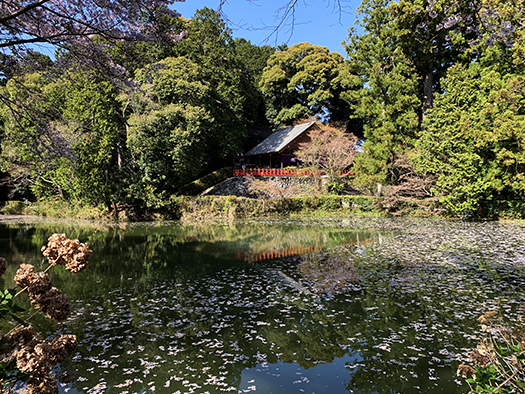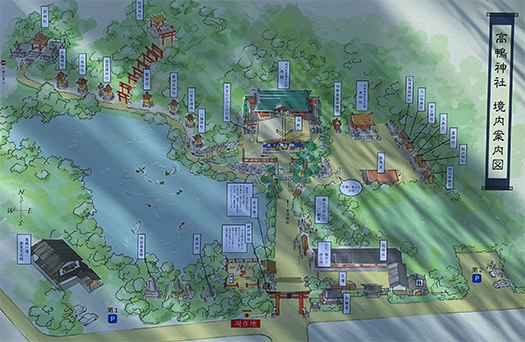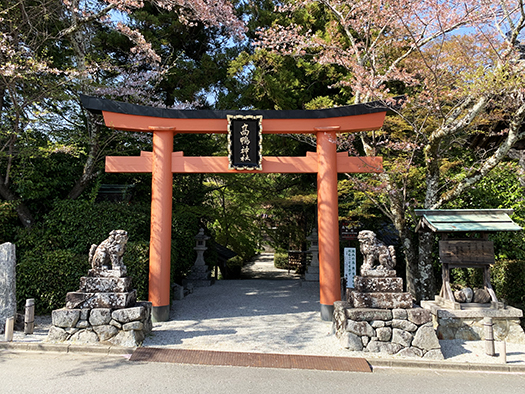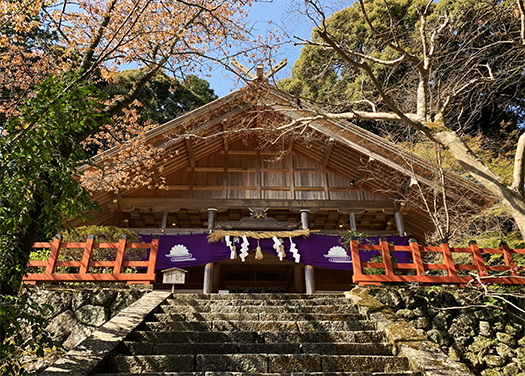


奈良県を逍遙していて御所<ごせ>町探訪でクルマで歩いていたら
ふとしたことから道に迷い、そのまま走っている内にたどりついたのが
この「高鴨〜たかかも〜神社」。
予備知識もなくクルマを停め周辺の池越しに社を遙拝した。
サクラ満開時期だったので水面に桜吹雪がうかぶ先にお姿をみた。
標高が300mほどの高台であり、自然の池面なのかどうか、
その配置計画の妙に打たれつつ、写真に収めておりました。
〜当神社は全国鴨(加茂)社の総本宮で
弥生中期より祭祀を行う日本最古の神社の一つです。
主祭神 阿遅志貴高日子根命(迦毛之大御神)
事代主命 阿治須岐速雄命 下照姫命・天稚彦命
●この地は大和の名門豪族・鴨一族発祥地で本社はその鴨族が守護神として
祀った社の一つです。『延喜式』神名帳には「高鴨阿治須岐詫彦根命
(たかかもあじすきたかひこねのみこと)神社」とみえ月次・相嘗・新嘗祭には
官幣に預かる名神大社で最高社格をもつ神社でした。清和天皇859年正月には、
大和の大神神社や大和大国魂神社とならんで従二位の御神階だったのが
御祭神もともに従一位に叙せられました。それほど由緒をもつ古社。
●弥生中期、鴨族の一部はこの丘陵から大和平野西南端、今の御所市に移り、
葛城川の岸辺に鴨都波神社をまつって水稲生活をはじめました。
また東持田の地に移った一派も葛木御歳神社を中心に水稲耕作に入りました。
そのため一般に本社を上鴨社、御歳神社を中鴨社、鴨都波神社を下鴨社と
呼ぶようになりましたが、ともに鴨一族の神社であります。
このほか鴨の一族はひろく全国に分布しその地で鴨族の神を祀りました。
賀茂(加茂・賀毛)を郡名にするものが安芸・播・美濃・三河・佐渡にみられ、
郷村名は数十におよびます。中でも京都の賀茂大社は有名ですが、
本社はそれら賀茂社の総社にあたります。(由緒書きより)〜

建築という概念は日本人にはその外縁的空間も一体のものという意識が強い。
建物自体は空間の中での「句読点」というようにも受け取れる。
そういった意味合いではこの高鴨神社の空間性にはまことに1本取られた感。
古代以来の日本人の「空間の美意識」がはるかに伝わってくる。
池水と神社建築とが常に相互浸透する関係にありそう。
四季折々の自然環境の移り変わりが社を飾っていく。
その輪廻転生感がたぶん至福の宗教的体験性を持っているのではないか。
さすがに全国に400あると言われる「加茂(賀茂)鴨」社の本宮だけある。
一種、スピリチュアルな体験感で迫ってくる空間に久しぶりにハマった(笑)・・・
English version⬇
Zenkoku Kamosha “Hongu” Takagamo-jinja Shrine Nara, Asuka Search-14
The Japanese sense of beauty of space since the Jomon and Yayoi periods. The effort to skillfully incorporate the natural environment into the spatial elements is reminiscent of Japanese architecture itself. Nara, Asuka
When I was walking around Nara Prefecture by car to visit Gose Town, I suddenly lost my way.
I was walking in my car to visit the town of Gose when I suddenly got lost on the road.
Takakamo Shrine.
Without any prior knowledge of the shrine, I parked my car and walked to the shrine over the surrounding pond.
The cherry blossoms were in full bloom, so I saw the shrine ahead of me with a blizzard of cherry blossoms on the surface of the water.
The pond is located at an elevation of about 300 meters above sea level, and I wondered if the surface of the pond was natural or not.
I was struck by the oddity of the layout of the pond and took pictures of it.
〜The shrine is the head shrine of Kamo (Kamo) shrines throughout Japan and is one of the oldest shrines in Japan.
It is one of the oldest Shinto shrines in Japan, and has been performing rituals since the middle of the Yayoi period.
The main deity, Atoshikitakahikone-mikoto (Kamo no Mikoto)
Kotoshironomiki-no-mikoto, Asuki-hayo-no-mikoto, Shimoteruhi-no-mikoto, Ama-no-Wakuhiko-no-mikoto
This shrine is the birthplace of the Kamo clan, a prestigious Yamato clan.
The head shrine is one of the shrines enshrined as a guardian deity by the Kamo clan. The shrine is one of the shrines enshrined as a guardian deity of the Kamo clan.
(The shrine is dedicated to the deity Takakamo Ajisukitakahikone-no-mikoto at the monthly, year-end, and new harvest festivals.The shrine had the highest rank among Meishin-taisha shrines, and was officially recognized as such by the government. In the 859th year of the reign of Emperor Seiwa
In the first month of 859, the shrine was ranked as the second highest in the hierarchy of deities, along with the Ookami Shrine and the Yamato Okunitama Shrine in Yamato.
The shrine’s deities were also elevated to the first rank. The shrine is an ancient shrine with such a long history.
In the mid-Yayoi period, a part of the Kamo tribe moved from these hills to the southwestern edge of the Yamato Plain in present-day Gosho City.
They built the Kamotonami Shrine on the bank of the Katsuragi River and began to live on paddy rice.
Another group that moved to Higashimochida also began to cultivate paddy rice, centering on the Katsuragi Gozai Shrine.
As a result, the head shrine was generally called Kamigamo-sha (Kami-kamo Shrine), the Gozai Shrine was called Nakagamo-sha (Nakamo Shrine), and the Kamotonoha Shrine was called Shimogamo-sha
Both shrines belong to the Kamo clan.
The Kamo clan was widely distributed throughout the country, and the Kamo deities were enshrined at their shrines.The Kamo (Kamo or Kage) clan is found in the county names of Aki, Hari, Mino, Mikawa, and Sado.
There are dozens of township and village names. Kamo-taisha in Kyoto is the most famous of these.
The head shrine is the head shrine of these Kamo shrines. (From the history of the shrine) ~.
The Japanese have a strong sense of the concept of architecture as an integral part of the external space.
The building itself can be seen as a “punctuation point” within the space.
In this sense, the spatiality of the Takagamo Shrine is a real coup.
It conveys the Japanese people’s aesthetic sense of space that has existed since ancient times.
The relationship between the pond and the architecture of the shrine seems to be one of constant mutual penetration.
The changing natural environment of the four seasons adorns the shrine.
This sense of reincarnation is perhaps a blissful religious experience.
This is indeed the main shrine of the Kamo Kamo shrine, of which there are said to be 400 throughout Japan.
It was the first time in a long time that I fell in love with a space where I felt a kind of spiritual experience (laugh)…
Posted on 4月 29th, 2022 by 三木 奎吾
Filed under: 住宅マーケティング, 歴史探訪







コメントを投稿
「※誹謗中傷や、悪意のある書き込み、営利目的などのコメントを防ぐために、投稿された全てのコメントは一時的に保留されますのでご了承ください。」
You must be logged in to post a comment.